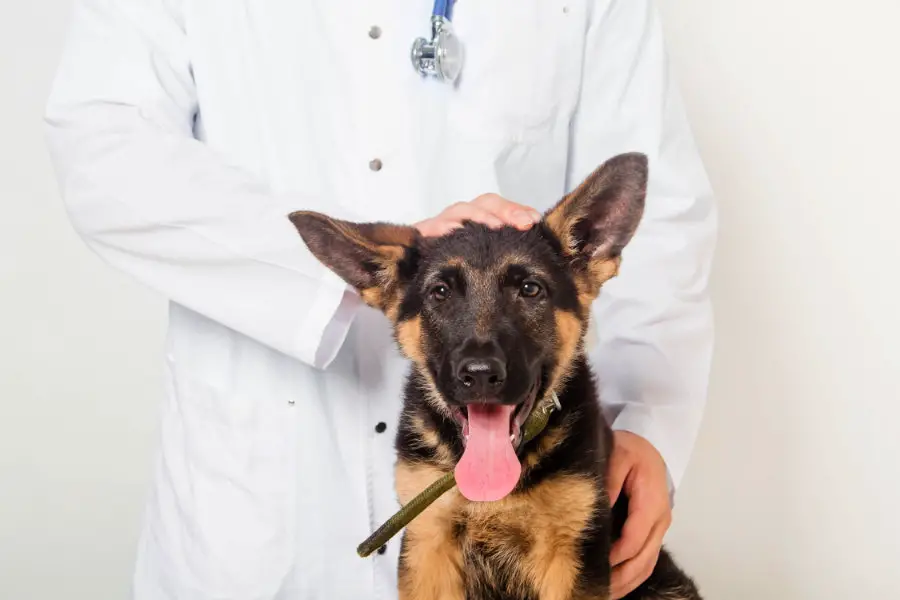When is it safe to spay a Germans Shepherd puppy? Why should a dog owner wait before having their puppy spayed?
Yes, 8 weeks is too early to spay a German Shepherd puppy or any dog, for that matter. Traditionally, six months of age has been the most commonly recommended time for spaying or neutering dogs, although this can vary based on breed, size, and health considerations.
Before you decide to spay your German Shepherd puppy, it is crucial to understand the safest time to do so, so you can reasonably determine whether or not it is time. Being informed about your choices and the impact spaying will have on your puppy later in life could make your decision much more straightforward.

Why Spay Your German Shepherd Puppy?
According to the American Kennel Club, the action of spaying or neutering pets is now considered to be a common practice in America. Any animal not kept intact for breeding is usually castrated or has an ovariohysterectomy as soon as they reach a safe age.
The push to make spaying and neutering pets a routine practice was done by veterinarians and animal shelters in an effort to cut down on the number of homeless or unwanted pets that were overwhelming the streets.
From 2019 to 2020, 78% of American dog owners had this done for their pets.
As many as 1.5 million pets are euthanized every year in the US. Many of these deaths result from responsible pet owners who did not have their animals spayed or neutered and allowed them to breed unwanted litters that ended up in shelters across the country.
There are also certain health risks that are greatly reduced by spaying your dog. For example, an infection of the uterus called pyometra can develop in unspayed female dogs and can be quite painful and life-threatening.
Spaying also lowers the chances of your female dog developing breast tumors.
Female dogs are also less likely to wander off after being spayed than those who have not. It also lowers the chances that your dog will urinate or “spray” all over the house and howl for a mate.
Why Not Spay and Neuter as Early as Possible?
This information may make you wonder why you shouldn’t just go away and spay your German Shepherd as early as possible.
Spaying or neutering a dog at the age of 8 weeks, however, is simply not healthy for the animal.
There are risks involved in conducting these practices too early, but the age at which it is safe can differ for each breed. For example, there are several reasons that you should not spay a German Shepherd puppy before they are at least 6 months old.
Reasons to Wait on Spaying
While some of the reasons for waiting are specific to the German Shepherd breed, others are true of any puppy. Understanding these could help you see why it is better to put off spaying for a while.
- Increased Cancer Risk – Spaying a German Shepherd puppy that is under 6 months old can increase the dog’s risk of developing certain cancers. For this reason alone, it is recommended that the dog is not spayed before that age.
Aside from breast cancer, mast cell tumors, hemangiosarcoma, and osteosarcoma were also more prevalent in GSDs that had been spayed at a young age.
- Higher Percentage of Joint Issues – Early spaying can also be linked to a much higher percentage of joint and mobility issues in German Shepherds.
The numbers jumped from 5% of unspayed female dogs developing these issues to as much as 16% if they were spayed before 1 year of age. - Greater Chance of Developing Incontinence – There was also a greater chance of female dogs developing urinary incontinence if they had been spayed before they turned a year old. No intact females showed this issue as they aged, while 7% of early-spayed dogs did.
Knowing this, you can see why it is considered much better to wait until your German Shepherd puppy is at least 6 months old before you spay them. There are simply too many health risks associated with this practice.
Waiting until they are a year old is even more ideal if you are able to monitor them closely to avoid any unwanted pregnancies should they go into heat before that age.
Note that the AKC does not recommend spaying a dog while it is in heat since this can lead to excessive bleeding.

When is the Best Time to Spay a German Shepherd Puppy?
The timing of spaying a dog can depend on several factors, such as breed, individual health, and the advice of your vet. Traditionally, puppies were typically spayed or neutered at about six months of age.
However, more recent research has suggested that for larger breed dogs like German Shepherds, it may be better to wait until they have fully matured to allow for complete growth, including bone and joint development. This could mean waiting until the dog is between 12-24 months old, and in some cases, even longer.
There is evidence that early spaying/neutering can increase the risk of certain health issues in larger breeds, including orthopedic problems like hip dysplasia and cruciate ligament injuries. These conditions are more common in large breeds and could potentially be exacerbated by altering the hormones that regulate growth too early.
On the other hand, spaying helps prevent mammary tumors and uterine infections in female dogs, and the risk of these decreases the earlier the procedure is done before the first heat cycle.
Therefore, there’s no one-size-fits-all answer to this question. It’s best to discuss the timing of spaying or neutering your German Shepherd with your vet. They can provide advice that takes into account the latest research, the specific breed considerations, and your dog’s individual health history and lifestyle.
What to Do After Your Dog Has Been Spayed
After you have had your German Shepherd spayed, you will need to take a few steps to help them heal safely and calmly.
- Provide your dog with a quiet place to sleep away from other pets and children.
- Allow them 1 month to heal with little activity; no running, jumping, or other physically demanding actions.
- Keep an eye on the wound. If it swells a lot, develops unusual bruises, oozes, smells, or just seems questionable, do not hesitate to call the vet.
- Make sure that your dog wears the collar or cone that the vet will send home with them. This will help stop them from licking the wound and causing it to open. It is usually okay to remove this within 8 days, but be sure to verify with your vet.
What if I Can’t Afford to Spay My German Shepherd?
Hard times can hit anyone, and in some cases, a person may have unexpected expenses that come after they’ve brought home a pet. If this has happened to you, there are options available.
Many veterinarians run regular spay and neuter clinic days when they drastically cut the cost of spaying and neutering pets for the public. This is another part of their ongoing efforts to lower the population of unwanted pets.
For some breeds, such as pit bulls, this service is offered for free. You can check with your local animal shelters and veterinary hospital to see if this is available for German Shepherds and determine the exact cost.
If you choose this option for spaying your German Shepherd, be aware that it is a cost-efficient method, and therefore the pets will not have the usual recovery time that they would at your regular vet.
Conclusion
While it is very beneficial to spay your German Shepherd, doing so at an early age can greatly increase many health risks for your dog.
You should always discuss your dog’s health, genetics, and other factors with your vet before making decisions about medical procedures.
